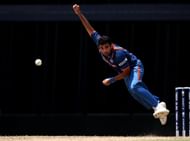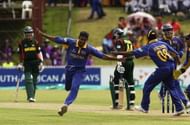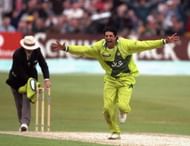I have always been fascinated by left-arm bowlers. They exude a certain charm, a whole different variety of style, and it is usually very difficult for batsmen to score runs off them. The way they move the ball either into or away from the willow wielders is nothing short of magical.
While the quicker bowlers have been more than a perfect foil for their right-handed counterparts, the slower segment hasn’t done too badly either. They give a team just the right variety in their bowling arsenal.
Although both sets of bowlers are susceptible to profligacy, they are usually very accurate with their line and length.
Here is a list of the top five left-arm bowlers in ODIs:
5. Mitchell Johnson (Australia)When the lanky left-arm pacer was attending a fast-bowling coaching clinic in Brisbane at the age of 17, Australian great Dennis Lillee termed him as a once-in-a-lifetime prospect. He has the ability to consistently swing the ball into the right-hander; a skill he mastered on the 2009 tour to South Africa.
Johnson’s performance in the ODI arena has dipped in recent times, but in his seventh match, he proved Lillee’s words to be true with a brilliant spell of 4/11 against India. He proved to be simply unplayable on that Malaysian track, troubling the batsmen with his pace and bounce. England were on the receiving end during the CB series as Johnson wrecked their line-up with a four-wicket burst in just eight balls.
Of late, though, Johnson has struggled with injuries and a prolonged slump in form. His wrist position is improper and he seems to be trying too hard and too many things while sending down his thunderbolts. Nevertheless, he is still a fine prospect for the Aussies in the long run.
4. Daniel Vettori (New Zealand)
The lion-hearted left-arm orthodox spinner, who plays for the Northern Districts Knights in NZ cricket, has matured into a useful bowling all-rounder. One of the few players to use prescription spectacles on the field, the former skipper has been one of the best spinners in both ODIs as well as Tests.
Vettori made his debut in the 1996-97 season as an 18-year old, and over a seventeen-year span, has emerged as a force to reckon with, particularly in the ODI arena. Known for his unerring accuracy, guile and clever use of flighted deliveries, Vettori can not only choke the flow of runs but also pick up wickets with alarming regularity. He is also a useful batsman, making crucial contributions down the order. Despite his talent, Vettori has bagged only two five-wicket hauls in ODI cricket – 5/30 against the West Indies in 2004, and 5/7 against minnows Bangladesh in 2007.
With regular captain Stephen Fleming deciding to hang up his boots, the mantle of leadership passed to Daniel, and he led the Black Caps to the semi-finals of the 2011 World Cup in India. He retired from both ODIs and T20 internationals soon after, and his arm-ball, with which he tormented many leading batsmen, remains one of the lasting images of his tenure as a limited-overs cricketer.
3. Zaheer Khan (India)
He burst onto the international scene as a raw 22-year old in the ICC Knockout Trophy at Nairobi in 2000, making his debut alongside the stylish Yuvraj Singh. ZaK, as he’s popularly known as, has been the mainstay of the Indian pace attack since the retirement of Javagal Srinath. Once a bowler focused only on pace, he has since transformed himself into a complete package – replete with slower balls, the in-swinging yorker and the reverse swing.
Zaheer’s bowling style has often been compared to that of Pakistani great Wasim Akram, and over a period of time, he did enough to justify the arguments. He has the ability to swing the new ball and reverse-swing the old, is a keen competitor and has gained enough mastery over line and length in order to keep a batsman guessing. He was a star performer for India in both 2003 and 2011 World Cups, emerging as the joint highest wicket-taker in the last edition.
Each time he has been laid low by injuries, ZaK has always bounced back admirably. Currently India’s second-most successful bowler, the Shrirampur lad may well become a complete fast bowler (a moniker once bestowed upon the fiery Dennis Lillee) if he manages to go injury-free for a long period of time. A spell at Worcestershire only served to increase the number of tricks he had up his sleeve – the “ZaK Attack” will be back sooner than anyone thinks!
2. Chaminda Vaas (Sri Lanka)
Warnakulasuriya Patabendige Ushantha Joseph Chaminda Vaas was to Sri Lankan cricket what Dale Steyn is to the South Africans – a wicket-taking behemoth. Easily the most penetrative and successful Sri Lankan new-ball bowler, Vaas was often skipper Arjuna Ranatunga’s go-to man for breaking partnerships and providing the early breakthroughs. He formed a successful combination with the legendary Muttiah Muralitharan; together, they troubled international batsmen for more than a decade.
Vaas entered the record books when he wrecked Zimbabwe’s batting line-up with a hostile spell, finishing with the first ever eight-wicket haul in ODI cricket; his 8/19 still remain the best bowling figures in the shorter format. He was also notable for having taken a hat-trick with the first three balls of the game against Bangladesh in the 2003 World Cup.
Blessed with the ability to swing and seam the ball, Vaas also had a trademark delivery in the late in-dipper, along with a carefully disguised off-cutter; he once castled Virender Sehwag with that delivery in an ODI match in England. Age and persistent injuries forced him to bring the curtains down on a wonderful career in 2009.
1. Wasim Akram (Pakistan)
Any list comprising the greatest left-arm bowlers would be incomplete without the legendary Wasim Akram. The original ‘Sultan of Swing’ was deadly accurate and bowled with fearsome pace in his initial years. His most special talent was the ability to move the ball both ways in one delivery – a feat not yet matched by anyone else. Together with Waqar Younis, he formed a terrifying new-ball pair.
Akram became the first bowler to take two ODI hat-tricks in 1990 – one against the West Indies and the other against Australia; all the batsmen were bowled on both occasions. His ability to reverse-swing the ball led him to grab three key English wickets in the 1992 World Cup final, thus winning the Man of the Match award and helping Pakistan to lift the title.
Other highlights include captaining his side to the 1999 World Cup final, and holding the record for the most number of wickets (55) in World Cup matches. Match-fixing allegations and Pakistan’s early exit in the 2003 edition saw his international career end in a somewhat disappointing manner.
Nevertheless, Wasim Akram remains one of the greatest left-arm fast bowlers to have played the game.
Looking for fast live cricket scores? Download CricRocket and get fast score updates, top-notch commentary in-depth match stats & much more! 🚀☄️




